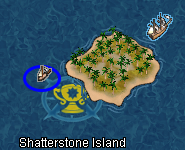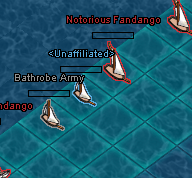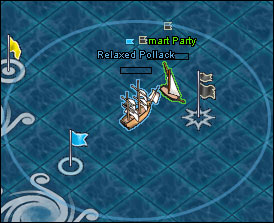Blockade
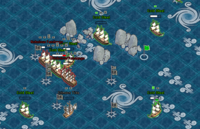
A blockade is the most common means by which a flag takes control of an island. A blockade is a large multi-ship sea battle in which factions vie for control of flagged buoys. Unlike regular sea battles, blockades do not involve grappling or swordfighting/rumbling.
A blockade is structured in a number of rounds, in a best-of-five format. Each round takes approximately 45 minutes and is followed by a 15-minute break. For more information on how to win a round, see the section on scoring.
For details on how a commanding officer controls the ship and navigates the board, see sea battle.
Contents
- 1 Declaring a blockade
- 2 Event blockades
- 3 Brigand King blockades
- 4 Blockaded islands
- 5 Winning a blockade
- 6 The blockade board
- 7 Mid-round breaks and watching the score
- 8 Jobber requirements
- 9 Blockade pay
- 10 Abandoned ships
- 11 What happens at the end of a blockade
- 12 Blockade history
- 13 Maneuvers
- 14 Sunken treasure
- 15 Trophies
- 16 Historical notes
- 17 See also
- 18 Other links
Declaring a blockade
During the hours that the Blockade Window is open, [3PM Friday - 3AM Saturday & 1PM Saturday - 3PM Saturday Game Time] Flag Royalty are the only ones who can declare a blockade. To do this, a member of royalty must be aboard a ship docked at the island to be blockaded. The royalty member must select the "Blockade" button under the Vessel tab. A confirmation box appears and the war chest must be paid at that time. Once that happens, the blockade automatically starts twenty-four hours later. See Pirate Time for an explanation of Daylight Saving Time changes.
To blockade a colonized island, the contending flag must have declared war on the flag that rules the island before the war chest is dropped. The declaration of war can not be rescinded until three days after the blockade ends.
Once a flag has declared a blockade, then any other flag may also join the blockade as a contender. The new flag must also pay for a war chest, but it may be paid any time before the blockade ends. There are a few examples of flags having paid a war chest after several blockade rounds have been completed. The flag that rules the island will be automatically entered into the blockade as the defender. Should the flag disband before the blockade, the island will have no defender (see Ventress LXX for an example of this).
A contending flag must have the required level of fame at the time it pays the war chest. The requirement varies depending on the size of the island.
- Outpost island - Noted
- Medium island - Established
- Large island - Renowned
At the present time, the initial war chest may only be paid between noon and midnight Friday or between 10 A.M. and noon on Saturday, Pirate Time. Thus, all blockades must begin between noon and midnight on Saturday or between ten and noon on Sunday.
Ocean Masters and Island Governors may create special event blockades that circumvent these rules.
Sinking vs. non-sinking
Blockades may be either sinking or non-sinking. In a sinking blockade, sunken ships disappear beneath the waves; the ship and all goods aboard are lost forever. In a non-sinking blockade, sunken ships fade out and reappear at the island where they were last in port, supplies intact. These ships may not reenter the blockade, but their supplies may be transferred to other ships in port.
Blockades of uncolonized islands are always sinking. At colonized islands, blockades default to non-sinking. The defending flag may choose to make the blockade sinking. To do so, the defending flag must declare war on at least one of the contending flags. This can be done at any time. If the blockade has already started, the change takes effect at the start of the next round. Attackers do not have any control over whether the blockade will be sinking, even if two contenders are at war with each other, the blockade will not be sinking unless one of them is at war with the defender.
![]() On the Obsidian Ocean, all blockades except for events are sinking.
On the Obsidian Ocean, all blockades except for events are sinking.
Keep in mind that not all islands can be blockaded. To find out which islands on the ocean can be blockaded consult the island notice board.
Pirates aboard a ship sunk during a sinking blockade may receive an injury.
Event blockades
- This section is a summary. For more information on event blockades, see Blockade event.
Governors may declare event blockades on their own islands at any time. During the event, the island's league point changes to a symbol with a golden cup. Special options may be added to the blockade board, for example only allowing Sloops in, or making the obstacles denser, or making the ships stay, even with full damage. Event blockades are listed on the normal notice board blockade tab, but will have (event) listed next to the name of the island.
Unlike normal blockades, ships can choose to avoid event blockades, porting and deporting as normal. To join the blockade, an officer with permission aboard ship must press the 'join event' button on the vessel panel.
Brigand King blockades
- Main article: Brigand King
Brigand Kings periodically declare blockades on player-held islands, seizing control of the islands if not defeated.
Blockaded islands
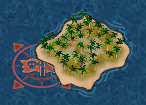
Once the blockade begins, the league point for the island changes from white to a red symbol with a skull and sword. The league point remains red until the blockade ends. For the duration of the blockade, all ships going into or out of port must cross the blockade board in order to reach the other side. The blockade board looks like a large sea battle board, complete with rocks, winds, and whirlpools.
A ship arriving at a blockaded island must decide whether to port (and cross the blockade board) or rechart to another island. Neither navy ships nor merchant brigands will enter a blockade. Islands with event blockades will have a golden cup on the league point.
Winning a blockade
The only way for a contending flag to win a blockade is to score the majority of rounds (i.e. three out of five). If this condition is not met then the defending flag, if any, wins by default and the island remains in its current state. For example, if the island is uncolonized, or has no defender due to a flag having disbanded, then the island remains ownerless. If, after a round ends, it is mathematically impossible for any contender to win, the blockade automatically ends, and the defender keeps the island. It is relatively uncommon for a blockade to default to the defender due to no contender having scored three rounds. One instance of this was the Celesta XXXV blockade in April 2013.
Event blockades may be configured for fewer than 7 rounds. The victory condition is still having won a majority of rounds.
If both the contenders and the defenders agree to end the blockade in one faction's favour, they may petition an Ocean Master to request that the blockade should end early. This happened during the Basset LXXV blockade in February 2014. The odd 5-0 victory was a result of the automatic termination of the blockade. Sometimes no agreement on the outcome of a blockade can be reached, as contending and defending flags may wish to force the other to spend PoE on guarding buoys for the remaining rounds. Note that an Ocean Master is never obliged to end any blockade ahead of time.
Winning a round
Each blockade round is scored separately. Each round takes approximately forty-five minutes and is followed by a fifteen minute break.
The winner of the round is the faction that scores the most points during the round. If the winning faction is neither a contender nor a defender, then the round is scored for the defender. This is true even for uncolonized islands where there is no defending faction.
If a round ends in a nonzero tie, the round goes into sudden death overtime and ends once one side takes a lead. If no points are scored during the round, the round is scored for the defender.
Factions
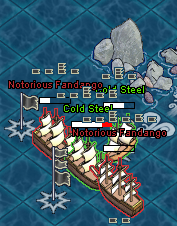
When a ship enters the blockade board, it is assigned to a faction. Points scored by the ship are added to the faction's total. A ship's faction is determined by the flag it belongs to. If the ship's flag is a contender or the defender, then the ship belongs to that faction. If the ship's flag is directly allied to an existing faction, the ship is added to that faction. If the ship's flag does not meet either of those criteria, then a new faction is created for the duration of the round. This can sometimes lead to confusing lists of factions due to the presence of observer ships watching from the safe zones.
It is impossible for a ship allied to both factions to enter the blockade unless one of the alliance proposals was finalized after the war chest was dropped. War cannot be declared on the ally of an ally.
Note that even if a ship deed is swapped out of the faction while on the blockade board, it will continue to contribute points to the same faction that it entered the board under.
Friendly fire rules apply to all ships within the same faction, where a 'friendly' ship will only inflict half the damage it would have caused had it belonged to another faction.
The blockade board
The blockade board is 20 squares wide and 30 (36 with safe zones) squares long. At one end is a representation of the island. The other end is blank, but leads to the ocean. Ships can leave the board at each end, but not through the sides.
The board is reset at the start of each round. Any ships on the board during the reset are ejected. All ships eject from the safe zone and are ported island-side. However, contender ships remaining in the blockade zone are ejected and deported ocean-side.
Buoys and scoring
During a round, the blockade board has several buoys scattered across it. (Buoys are sometimes referred to as "flags.") Each buoy has one, two, or three pennants. The number of pennants indicates the point value of the buoy. Buoys are always placed on open water—never on rocks, winds, or whirlpools. Despite appearing to be solid poles, buoys are not obstacles; ships may sail onto or through buoys with no ill effects.
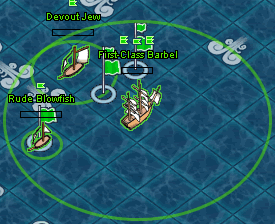
Each ship that enters the blockade has the possibility to influence the buoys and score points. However, a ship will have no influence if there are not enough pirates aboard; the larger the ship, the more pirates required (swabbies and non-subscribers never count towards the number needed). See the individual ship entries for the minimum number of players required for each type of ship. The zone of influence is a circle around the ship; the larger the ship, the larger the circle. Move the mouse pointer over any ship to see the zone of influence for all ships in that faction.
A buoy is scored for one side when that faction has uncontested influence over it at the end of a turn. Each buoy is counted only once, even if multiple ships of the controlling faction influence it. If ships from different factions both have influence over the same buoy, it is considered "contested", and no faction scores points from that buoy.
Above each ship are icons representing how many buoys it is currently influencing, including contested buoys. The icons also indicate the point value of the buoys.
A ship remains in its faction until it leaves the blockade board. This is true even if the ship's deed changes hands or the flag that owns the ship allies with one of the other factions. If a flag drops a chest part way through a round, a new faction is created. This may mean that there are two factions with the same name, one of them contending and the other defending or non-aligned.
Once the round is over, the buoys are removed from the field, although the board remains the same until the start of the next round.
The safe zones
There are two safe zones, one on each end of the board. Each safe zone is three rows long and is a lighter color than the rest of the board. There are no rocks, winds, whirlpools, or buoys in the safe zones.
When a ship enters the blockade board, the ship is randomly placed along the outer edge of the zone, facing towards the other end of the board.
Once a ship crosses from the safe zone into the main blockade board, it cannot return. Any attempt to enter the safe zone is treated as an attempt to exit out that side of the board. Ships belonging to the contending faction may not put into port at a colonized island. Instead, they "bounce" off the safe zone and find themselves facing back into the board.
Ships in the safe zone cannot be sunk. They cannot shoot. If they are shot by a ship outside the safe zone, they take no damage. They can, however, be rammed; thus they may be pushed around by other ships, and can even be pushed out of the safe zone.
When a ship is in a safe zone, the commanding officer can click the Disengage button and the ship will exit the blockade and return to whichever side (island or ocean) that the ship arrived from, providing that it is not a break. If moves are in progress, then the button may be clicked once, and the ship will be ejected after all moves for that round have been made. However, there is one important exception: if the ship belongs to a contending faction during a blockade of a colonized island, then it is ejected to the ocean side, regardless of which side it entered from.
Colors
Ships and buoys use colors to denote which faction controls them. When a pirate views the board, the ships and buoys belonging to the same faction as that pirate are always blue. Green represents the defending faction. Red is for all contending factions. All other factions are grey. Yellow buoys are not controlled by any faction. Black buoys are contested by two or more factions.
Buoys that are not controlled by anyone also have two small concentric circles around their base. Controlled buoys have a single circle around their base. Contested (black) buoys have an eight-pointed star around their base.
Mid-round breaks and watching the score
There are four one-minute breaks during each round. The first begins with 35:00 remaining in the round. The second occurs with 26:15 remaining, the third with 17:30 remaining, and finally with 8:45 remaining. When these breaks occur, no ship movement is possible. All puzzlers receive a duty report, as if they'd reached a league point.
The duty reports contain the current score. The score is also available on the vessel panel at any time for those not in a puzzle. Clicking on a faction's name toggles between showing just the name, the ship names belonging to the faction, and the names of the flags belonging to the faction. These lists only apply to ships and flags currently on the blockade board including the safe zones.
Jobber requirements
In order for a ship to be able to enter the blockade board, all pirates on the ship must meet the following requirements:
- Participants can not be greenies or unsaved guest accounts.
- Participants need to have at least Narrow experience in two or more piracy puzzles.
If a vessel attempts to enter a blockade but does not meet these requirements, a message will be sent listing the pirate names who are not eligible. The vessel will be unable to join the blockade until all pirates on board meet the above conditions.
In addition, in order to score points, the ship must have enough pirates to have influence and on subscriber oceans, only subscribers count toward this minimal number.
Blockade pay
- This section is a summary. For more information on blockade pay, see blockade pay.
Flags can specify an automatic payment system for jobbers. In order to collect payment, jobbers must be on ships that are configured at the helm to accept blockade jobbers, and they must be actively working at stations. Payment comes every break in the blockade action, and a jobber must be working for the majority of the previous blockade segment to receive pay.
The current systems for pay are:
- Even- Everyone who works gets paid evenly.
- Performance- Higher-scoring pirates earn more
- Elite- A more extreme version of the Performance system.
- Gunner's Glory- Gunners are paid more than other jobbers.
- Jobber's Delight- Members from outside the participating crews are paid more.
- Jobbers Only- Members from the participating crews are not paid.
Since pay is listed per segment, and there are five segments per round, multiply the payment by five for an approximation of payment per-round. Payment listed is for an average performance, and will be modified by the scheme chosen, above. If jobbing in a blockade solely for pay, a pirate should consider his or her own skills and the payment method chosen to decide what side to take. An average or below-average puzzler won't earn much in a blockade paying elite puzzlers more, while an elite puzzler will earn less on Even cuts than on an Elite or Performance pay scale.
Abandoned ships
Ships are sometimes abandoned either in the blockade board or at the league point at the island.
Abandoned in blockade
Non-sinking
A ship is sometimes abandoned in a non-sinking blockade if it has too much damage / bilge and a decision is made to bring in a fresh ship quickly rather than spend time trying to fix the ship. The ship will remain on the board until the beginning of the next round (or if in the last round, the end of that round) unless someone shoots it enough to "sink" it to knock it out. Either way it will then be abandoned at sea at the league point of the island where it was last docked, until either someone boards it to port it or the ship resets and ports itself.
Sinking
In a sinking blockade, an abandoned ship can and probably will be sunk, and the ship and all its supplies will be lost forever. However, ships are rarely abandoned in a sinking blockade, as most people prefer to fight it out to the end and inflict as much damage as possible to their opponents, or will try to sail their ship to the safe zone.
Abandoned at league point
When a flag is at war with the island holders they are unable to port their ships at the island. This often results in ships that were badly damaged in the blockade but that were not sunk but managed to reach the safe zone and exit, being abandoned at the league point. These ships will be ported when the ship resets and ports itself.
What happens at the end of a blockade
If the island was already owned by a flag and it is successfully defended, the island remains as is with the addition of a percentage of the war chest being added to the palace / fort coffers. (See war chest for more info.)
In the event that a contender wins the island, the contending flag's monarch is automatically installed as the governor. If the flag has no monarch, one royal is chosen at random to become governor. Additionally, all infrastructure building deeds are automatically transferred to the new governor. This includes the fort / palace, bank, bazaar, commodities market, and estate agent, as well as any unfinished construction sites. On large and medium islands, shoppe and inn deeds do not automatically transfer, but on outpost islands the single shoppe deed will automatically transfer. No portion of the war chest is added to the palace / fort coffers.
Blockade history
The first blockade ever was for Emperor Island on Midnight. History for each ocean is maintained here:
- Current Oceans
- Cerulean blockade history
- Emerald blockade history
- Meridian blockade history
- Obsidian blockade history
- Old Oceans
- Cobalt blockade history
- Hunter blockade history
- Malachite blockade history
- Midnight blockade history
- Sage blockade history
- Viridian blockade history
Maneuvers
- Main article: Maneuver
Ships in a blockade can earn special maneuvers, which allow them to execute special moves that may gain an advantage over their opponents.
Sunken treasure
- Main article: Sinking
Sunken Treasure appears on the board in sinking blockades when a vessel is sunk, allowing other vessels to haul booty from it.
Trophies
The following trophies are related to blockades:
- Blockade Trophies
Historical notes
- release 2004-04-28: Blockades implemented as part of "Bazaar Blockades![1]
- release 2004-11-22: Weekend restrictions were put in place. Prior to this, blockades could be declared at any time, giving a 24 hour notice to the defenders.
- release 2004-12-11: Blockades were limited to five rounds, requiring three to win. Prior to this, blockades ran a maximum of twelve rounds. A contender needed seven rounds to win the island. Originally, the twelve rounds were each separated by a one hour break. Later, the rounds were grouped into three rounds separated by a four hour break. A full twelve-round blockade would thus be active for three hours, break for four, active for three, break for four, active for three, break for four, and finally active for three. There was always a fifteen minute break after each round, just as it remains today.
- release 2005-05-02: Fame was implemented, limiting which flags may drop a war chest.
- release 2006-10-17: Jobber pay was implemented, meaning that all jobbers get what the flag announces as pay. Also, governor-initiated event blockades were added.
- release 2007-01-25: Maneuvers were released on production oceans. Blockade duty puzzles no longer cause puzzle standings to fall.
- release 2007-10-16: Puzzle standing protection was removed.
- Prior the November 6, 2015 blockade window, there was a break of one hour and fifteen minutes in between rounds three and four, and the drop window and blockade window were 24 hours long each. A blockade could be declared between noon Friday and noon Saturday, Pirate Time, so all blockades began between noon on Saturday and noon on Sunday.
- Starting with the weekend of January 15, 2016, a two-hour drop window was added to Saturdays, allowing blockades to once again be scheduled for Sundays, if only during those two hours.
See also
- Blockade pay
- Pay convention
- Brigand King blockades
- Category:Blockade propaganda - examples of artwork used as blockade & war propaganda
- Collision mechanics
- Current blockades
- Event blockades
- Pirate Time
- War
- Tutorials
- Admiraling a blockade - Work in progress
- Blockade coordination - Work in progress
- Blockade Planning - Work in progress
- Blockade tricks
- The Fandango Blockade Method
Other links
- Official game documents
- Commonly discussed ideas from Game Design
- Blockade News and Island Openings forum thread
- Blockade closings
- Blockade Nav Videos
- http://piratehost.org/docs/Eta_Blockade.html - Eta VI blockade October 28th 2006
- http://www.notoriousfandango.com/propaganda.php - Notorious Fandango Blockade Videos
- http://www.blockadevideos.com - Blockade Videos





